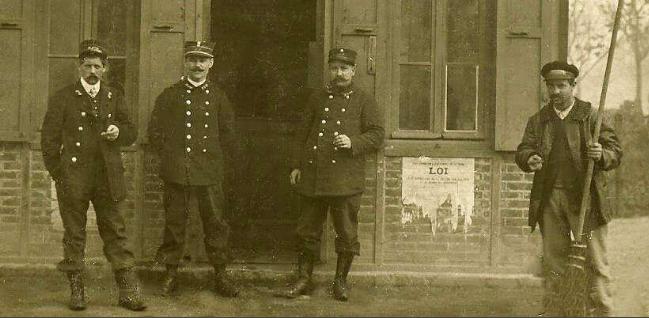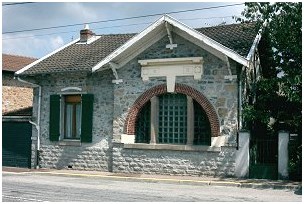
-------------------oOo-------------------
[FR]
L’octroi, impôt local indirect, a alimenté les caisses municipales de toutes les villes de France pendant près d’un siècle et demi. Il a eu cours tout au long du XIXe siècle et jusqu’à la Seconde guerre mondiale.
Les taxes d’octroi étaient encaissées à l’entrée des villes. Les bureaux d’octroi, bâtiments municipaux, étaient le lieu officiel de la perception de l’impôt. L’ensemble des bureaux d’octroi définissait un périmètre qui correspondait, peu ou prou, à la ville dense et industrieuse, par opposition à la campagne environnante.

Ce prélèvement fiscal sur la circulation des marchandises avait un petit air d’Ancien Régime. On appelait, sur le papier, les employés municipaux de l’octroi, les octroyens, mais, dans la vie de tous les jours, ils étaient les gabelous reconnaissables à leur uniforme. La gabelle n’avait pas complètement disparu des mémoires et du vocabulaire !

Gabelous en uniforme
Les bureaux d’octroi inscrivaient l’impôt dans l’espace. Ils cernaient la ville, marquaient des limites à chaque route d’accès, créaient des « portes » d’entrée à franchir. Malgré la petitesse de leur superficie, leur architecture devait s’imposer et soutenir leur fonction. Elle est modeste mais soignée. Proportions élégantes, bande décorative en bois découpé ou en pierre de taille, marquise pour servir d’abri.
Ce « petit » patrimoine bâti a aujourd’hui en grande partie disparu. Nous avons retrouvé à Limoges deux témoignages de cette époque : voir le second bureau de l’octroi à Saint-Lazare : Tramway de la Haute-Vienne : l'octroi de St Lazare GC6783H
L’octroi étant un point de passage obligatoire, il correspondait en généralement à un arrêt du tramvay. C’est encore le cas ici mais le trolleybus a remplacé le tramway depuis les années 50.
La difficulté est en partie liée à l’exposition aux moldus : soyez prudents et discrets pour votre survie et celle de la boîte !

Octroi de Saint-Lazare transformé en habitation (porte condamnée en façade)
Pourquoi "VERT" ?
Ma première cache posée (GC3VHY2) était une boîte verte, avec un stylo vert, un log book vert et des objets d'échange verts. Ainsi est née l'idée de placer les caches qui ont suivi sous le signe du "VERT" et de proposer un challenge consistant à y déposer de préférence des objets "VERTs". Ce challenge ne peut malheureusement pas concerner les caches de taille nano ou micro.
[EN]
The granting ("Octroi" in French), the indirect local tax, fed the municipal treasury of all the cities of France during almost one and a half century. It was current throughout the XIXth century and up to the Second World War.
This tax collection on the circulation of goods had a small air of Ancien Régime. We called, on the paper, the municipal employees of the granting, the "octroyens", but, in the daily life, they were the recognizable "gabelous" (salt-tax collectors) in their uniform. The salt tax had not completely disappeared from minds and from the vocabulary !
The taxes of granting were collected in the entry of cities. The offices of granting, municipal buildings, were the official place of the tax collection. All the offices of granting defined a perimeter which corresponded, more or less, to the dense and industrious city, by opposition to the surrounding countryside.
The offices of granting encircled the city, marked limits in every access road, created "doors" of entrance to be crossed. In spite of the small size of their surface, their architecture had to stand out and support their function. It is modest but been looked after. Elegant proportions, wooden or stone ornamental parts, marchioness to serve as shelter.
This "small" built heritage disappeared today largely. We found in Limoges two testimonies of this period : see the second office of the granting in Saint-Lazare: Tramway de la Haute-Vienne: l'octroi de St Lazare GC6783H
The granting being a compulsory crossing point, it corresponded there generally to a stop(ruling) of the tramvay. It is still the case here but the trolley bus replaced the streetcar since the 50s.
The difficulty is partially due to the exposure in muggles : be careful and discreet for your survival and for the survival of the box!
Why "VERT" ?
My first geocache ( GC3VHY2) was a green box, with a green pen, a green log book and green items for exchange. So was born the idea to place the caches which followed under the sign of the "VERT" ("GREEN" in French) and to propose a challenge consisting in depositing there rather "VERT" items. This challenge cannot unfortunately concern the caches in nano or micro size.